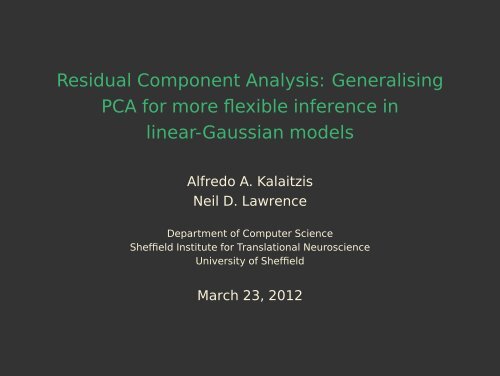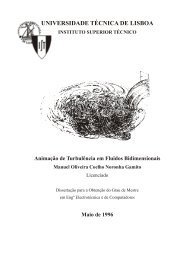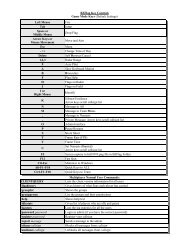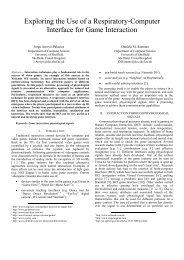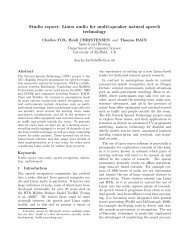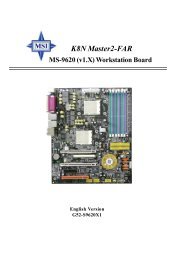Residual Component Analysis: Generalising PCA for more flexible ...
Residual Component Analysis: Generalising PCA for more flexible ...
Residual Component Analysis: Generalising PCA for more flexible ...
You also want an ePaper? Increase the reach of your titles
YUMPU automatically turns print PDFs into web optimized ePapers that Google loves.
<strong>Residual</strong> <strong>Component</strong> <strong>Analysis</strong>: <strong>Generalising</strong><br />
<strong>PCA</strong> <strong>for</strong> <strong>more</strong> <strong>flexible</strong> inference in<br />
linear-Gaussian models<br />
Alfredo A. Kalaitzis<br />
Neil D. Lawrence<br />
Department of Computer Science<br />
Sheffield Institute <strong>for</strong> Translational Neuroscience<br />
University of Sheffield<br />
March 23, 2012
Outline<br />
Probabilistic Principal <strong>Component</strong> <strong>Analysis</strong> (P<strong>PCA</strong>)<br />
<strong>Residual</strong> <strong>Component</strong> <strong>Analysis</strong> (RCA)<br />
Optimising a Low-rank + Sparse-Inverse Covariance Model<br />
Experimental Results
Probabilistic <strong>PCA</strong> (sensible <strong>PCA</strong>)<br />
(Hotelling, 33) (Roweis, 98) (Tipping & Bishop, 99)<br />
◮ P<strong>PCA</strong> seeks a low dimensional representation of a data<br />
set in the presence of independent spherical Gaussian<br />
noise σ 2 I.<br />
Y ∈ R N×p<br />
X ∈ R N×q<br />
p(x) = N (0, I)<br />
p(y|x) = N (Wx, σ 2 I)
Probabilistic <strong>PCA</strong> (sensible <strong>PCA</strong>)<br />
(Hotelling, 33) (Roweis, 98) (Tipping & Bishop, 99)<br />
◮ P<strong>PCA</strong> seeks a low dimensional representation of a data<br />
set in the presence of independent spherical Gaussian<br />
noise σ 2 I.<br />
Y ∈ R N×p<br />
X ∈ R N×q<br />
p(x) = N (0, I)<br />
p(y|x) = N (Wx, σ 2 I)<br />
◮ Marginalising the latent variable X gives,<br />
�<br />
n�<br />
p(Y, X|W)dX = p(Y|W) =<br />
i=1<br />
⊤ 1<br />
WML = UqLqR NY⊤Y = UΛU ⊤<br />
N (yi,:|0, WW ⊤ + σ 2 I)<br />
Lq = (Λq − σ 2 I) 1<br />
2
Dual P<strong>PCA</strong> (principal Coordinate analysis)<br />
(Lawrence, 06)<br />
◮ Instead of the latent variable X, we can place a prior<br />
distribution on the mapping W. Marginalising W instead<br />
of X,<br />
�<br />
p(Y, W|X)dW =<br />
the P<strong>PCA</strong> dual solution can be obtained <strong>for</strong><br />
likelihoods of the <strong>for</strong>m<br />
p(Y|X) =<br />
p�<br />
j=1<br />
N (y:,j|0, XX ⊤ + σ 2 I)
Dual P<strong>PCA</strong> (principal Coordinate analysis)<br />
(Lawrence, 06)<br />
◮ Instead of the latent variable X, we can place a prior<br />
distribution on the mapping W. Marginalising W instead<br />
of X,<br />
�<br />
p(Y, W|X)dW =<br />
the P<strong>PCA</strong> dual solution can be obtained <strong>for</strong><br />
likelihoods of the <strong>for</strong>m<br />
p(Y|X) =<br />
p�<br />
j=1<br />
N (y:,j|0, XX ⊤ + σ 2 I)<br />
◮ Note the conditional independence is across features.<br />
Now, dual-P<strong>PCA</strong> solves <strong>for</strong> the latent coordinates,<br />
XML = U ′ ⊤<br />
qLqR
From dual-P<strong>PCA</strong> to the GPLVM<br />
(Lawrence, 06) (Titsias & Lawrence, 10) (Damianou et. al, 11)<br />
◮ Note the covariance is an inner-product term (of latent<br />
variables) plus spherical-Gaussian noise.<br />
p(Y|X) =<br />
p�<br />
j=1<br />
N (y:,j|0, XX ⊤ + σ 2 I)
From dual-P<strong>PCA</strong> to the GPLVM<br />
(Lawrence, 06) (Titsias & Lawrence, 10) (Damianou et. al, 11)<br />
◮ Note the covariance is an inner-product term (of latent<br />
variables) plus spherical-Gaussian noise.<br />
p(Y|X) =<br />
p�<br />
j=1<br />
N (y:,j|0, XX ⊤ + σ 2 I)<br />
◮ This likelihood is a product of independent Gaussian<br />
processes with linear kernels (or covariance functions).
From dual-P<strong>PCA</strong> to the GPLVM<br />
(Lawrence, 06) (Titsias & Lawrence, 10) (Damianou et. al, 11)<br />
◮ Note the covariance is an inner-product term (of latent<br />
variables) plus spherical-Gaussian noise.<br />
p(Y|X) =<br />
p�<br />
j=1<br />
N (y:,j|0, XX ⊤ + σ 2 I)<br />
◮ This likelihood is a product of independent Gaussian<br />
processes with linear kernels (or covariance functions).<br />
◮ A generalisation of the above to a non-linear kernel (but<br />
still an inner-product in some Hilbert space) is known as<br />
the Gaussian Process Latent Variable Model (GPLVM).
<strong>Residual</strong> <strong>Component</strong> <strong>Analysis</strong><br />
◮ Discussed: low-rank + spherical noise term.
<strong>Residual</strong> <strong>Component</strong> <strong>Analysis</strong><br />
◮ Discussed: low-rank + spherical noise term.<br />
◮ Next:<br />
XX ⊤ + Σ<br />
low-rank arbitrary positive definite
<strong>Residual</strong> <strong>Component</strong> <strong>Analysis</strong><br />
◮ Discussed: low-rank + spherical noise term.<br />
◮ Next:<br />
◮ Instances of Σ:<br />
XX ⊤ + Σ<br />
low-rank arbitrary positive definite<br />
◮ Σ<strong>PCA</strong> = σ 2 I
<strong>Residual</strong> <strong>Component</strong> <strong>Analysis</strong><br />
◮ Discussed: low-rank + spherical noise term.<br />
◮ Next:<br />
◮ Instances of Σ:<br />
XX ⊤ + Σ<br />
low-rank arbitrary positive definite<br />
◮ Σ<strong>PCA</strong> = σ 2 I<br />
◮ ΣFA = diag(a)
<strong>Residual</strong> <strong>Component</strong> <strong>Analysis</strong><br />
◮ Discussed: low-rank + spherical noise term.<br />
◮ Next:<br />
◮ Instances of Σ:<br />
XX ⊤ + Σ<br />
low-rank arbitrary positive definite<br />
◮ Σ<strong>PCA</strong> = σ 2 I<br />
◮ ΣFA = diag(a)<br />
◮ ΣCCA =<br />
� Y1Y ⊤ 1<br />
0<br />
0 Y2Y ⊤ 2<br />
�<br />
+ σ 2 I, <strong>for</strong> Y =<br />
� Y1<br />
Y2<br />
�
<strong>Residual</strong> <strong>Component</strong> <strong>Analysis</strong><br />
◮ Discussed: low-rank + spherical noise term.<br />
◮ Next:<br />
◮ Instances of Σ:<br />
XX ⊤ + Σ<br />
low-rank arbitrary positive definite<br />
◮ Σ<strong>PCA</strong> = σ 2 I<br />
◮ ΣFA = diag(a)<br />
◮ ΣCCA =<br />
� Y1Y ⊤ 1<br />
0<br />
0 Y2Y ⊤ 2<br />
◮ ΣLR = ZZ ⊤ + σ2 I<br />
�<br />
+ σ 2 I, <strong>for</strong> Y =<br />
� Y1<br />
Y2<br />
�
<strong>Residual</strong> <strong>Component</strong> <strong>Analysis</strong><br />
◮ Discussed: low-rank + spherical noise term.<br />
◮ Next:<br />
◮ Instances of Σ:<br />
XX ⊤ + Σ<br />
low-rank arbitrary positive definite<br />
◮ Σ<strong>PCA</strong> = σ 2 I<br />
◮ ΣFA = diag(a)<br />
◮ ΣCCA =<br />
� Y1Y ⊤ 1<br />
0<br />
0 Y2Y ⊤ 2<br />
�<br />
+ σ 2 I, <strong>for</strong> Y =<br />
◮ ΣLR = ZZ ⊤ + σ 2 I<br />
◮ ΣGP = K + σ 2 I s.t. Kij = k(zi, zj)<br />
� Y1<br />
Y2<br />
�
<strong>Residual</strong> <strong>Component</strong> <strong>Analysis</strong><br />
◮ Discussed: low-rank + spherical noise term.<br />
◮ Next:<br />
◮ Instances of Σ:<br />
XX ⊤ + Σ<br />
low-rank arbitrary positive definite<br />
◮ Σ<strong>PCA</strong> = σ 2 I<br />
◮ ΣFA = diag(a)<br />
◮ ΣCCA =<br />
� Y1Y ⊤ 1<br />
0<br />
0 Y2Y ⊤ 2<br />
�<br />
+ σ 2 I, <strong>for</strong> Y =<br />
◮ ΣLR = ZZ ⊤ + σ 2 I<br />
◮ ΣGP = K + σ 2 I s.t. Kij = k(zi, zj)<br />
◮ ΣGlasso = Λ −1<br />
s.t. �<br />
i,j (Λij �= 0) ≪ p 2<br />
� Y1<br />
Y2<br />
�
<strong>Residual</strong> <strong>Component</strong> <strong>Analysis</strong><br />
◮ Discussed: low-rank + spherical noise term.<br />
◮ Next:<br />
◮ Instances of Σ:<br />
XX ⊤ + Σ<br />
low-rank arbitrary positive definite<br />
◮ Σ<strong>PCA</strong> = σ 2 I<br />
◮ ΣFA = diag(a)<br />
◮ ΣCCA =<br />
� Y1Y ⊤ 1<br />
0<br />
0 Y2Y ⊤ 2<br />
�<br />
+ σ 2 I, <strong>for</strong> Y =<br />
◮ ΣLR = ZZ ⊤ + σ2 I<br />
◮ ΣGP = K + σ2 ◮<br />
I<br />
ΣGlasso = Λ<br />
s.t. Kij = k(zi, zj)<br />
−1<br />
s.t. �<br />
i,j (Λij �= 0) ≪ p 2<br />
◮ Given Σ, can we solve <strong>for</strong> X?<br />
� Y1<br />
Y2<br />
�
<strong>Residual</strong> <strong>Component</strong> <strong>Analysis</strong><br />
◮ Discussed: low-rank + spherical noise term.<br />
◮ Next:<br />
◮ Instances of Σ:<br />
XX ⊤ + Σ<br />
low-rank arbitrary positive definite<br />
◮ Σ<strong>PCA</strong> = σ 2 I<br />
◮ ΣFA = diag(a)<br />
◮ ΣCCA =<br />
� Y1Y ⊤ 1<br />
0<br />
0 Y2Y ⊤ 2<br />
�<br />
+ σ 2 I, <strong>for</strong> Y =<br />
◮ ΣLR = ZZ ⊤ + σ2 I<br />
◮ ΣGP = K + σ2 ◮<br />
I<br />
ΣGlasso = Λ<br />
s.t. Kij = k(zi, zj)<br />
−1<br />
s.t. �<br />
i,j (Λij �= 0) ≪ p 2<br />
◮ Given Σ, can we solve <strong>for</strong> X?<br />
� Y1<br />
◮ If so, <strong>more</strong> importantly, what <strong>for</strong>ms of Σ model <strong>for</strong><br />
important problems in machine learning?<br />
Y2<br />
�
<strong>Residual</strong> <strong>Component</strong> <strong>Analysis</strong><br />
(Kalaitzis & Lawrence, 11)<br />
◮ RCA theorem (dual version). The maximum likelihood<br />
estimate of X, <strong>for</strong> positive-definite Σ, is<br />
XML = ΣS(D − I) 1<br />
2 , (1)<br />
where S is the solution to the generalised eigenvalue<br />
problem (GEP)<br />
1<br />
p YY⊤ S = ΣSD.
<strong>Residual</strong> <strong>Component</strong> <strong>Analysis</strong><br />
(Kalaitzis & Lawrence, 11)<br />
◮ RCA theorem (dual version). The maximum likelihood<br />
estimate of X, <strong>for</strong> positive-definite Σ, is<br />
XML = ΣS(D − I) 1<br />
2 , (1)<br />
where S is the solution to the generalised eigenvalue<br />
problem (GEP)<br />
1<br />
p YY⊤ S = ΣSD.<br />
◮ Theorem extends to the primal version of RCA,<br />
WML = ΣS(D − I) 1<br />
2 ,<br />
1<br />
n Y⊤ YS = ΣSD.
<strong>Residual</strong> <strong>Component</strong> <strong>Analysis</strong><br />
(Kalaitzis & Lawrence, 11)<br />
◮ RCA theorem (dual version). The maximum likelihood<br />
estimate of X, <strong>for</strong> positive-definite Σ, is<br />
XML = ΣS(D − I) 1<br />
2 , (1)<br />
where S is the solution to the generalised eigenvalue<br />
problem (GEP)<br />
1<br />
p YY⊤ S = ΣSD.<br />
◮ Theorem extends to the primal version of RCA,<br />
WML = ΣS(D − I) 1<br />
2 ,<br />
1<br />
n Y⊤ YS = ΣSD.<br />
◮ Easier to see objective function by re-expressing into the<br />
equivalent regular symmetric eigenvalue problem.
Low-rank + Sparse-Inverse Covariance<br />
(Kalaitzis & Lawrence, 12)<br />
p(Λ) ∝ exp(−λ�Λ�1)<br />
p(z|Λ) = N (0, Λ −1 )<br />
p(x) = N (0, I)<br />
p(y|x, z) = N (Wx + z, σ 2 I)<br />
◮ Marginalising x and z from the joint log-density gives the<br />
objective<br />
log{p(Y|Λ)p(Λ)} =<br />
n�<br />
log{N (yi,:|0, WW ⊤ + ΣGlasso)p(Λ)}<br />
i=1<br />
�<br />
(bounded below by) ≥<br />
q(Z) log<br />
p(Y, Z, Λ)<br />
dZ<br />
q(Z)
Low-rank + Sparse-Inverse Covariance<br />
(Kalaitzis & Lawrence, 12)<br />
p(Λ) ∝ exp(−λ�Λ�1)<br />
p(z|Λ) = N (0, Λ −1 )<br />
p(x) = N (0, I)<br />
p(y|x, z) = N (Wx + z, σ 2 I)<br />
◮ Marginalising x and z from the joint log-density gives the<br />
objective<br />
log{p(Y|Λ)p(Λ)} =<br />
n�<br />
log{N (yi,:|0, WW ⊤ + ΣGlasso)p(Λ)}<br />
i=1<br />
�<br />
(bounded below by) ≥<br />
q(Z) log<br />
p(Y, Z, Λ)<br />
dZ<br />
q(Z)<br />
◮ Lower bound is maximised by a hybrid EM/RCA algorithm.
Optimising the LR + SI Covariance Model via EM/RCA<br />
◮ Initialise σ 2 , W and Λ.
Optimising the LR + SI Covariance Model via EM/RCA<br />
◮ Initialise σ 2 , W and Λ.<br />
◮ REPEAT<br />
◮ E-step: Update posterior density p(Z|Y) given current Λ.
Optimising the LR + SI Covariance Model via EM/RCA<br />
◮ Initialise σ 2 , W and Λ.<br />
◮ REPEAT<br />
◮ E-step: Update posterior density p(Z|Y) given current Λ.<br />
◮ M-step: Update Λ by GLASSO optimisation on the<br />
expected complete data log-density (expectation wrt<br />
current posterior p(Z|Y)).
Optimising the LR + SI Covariance Model via EM/RCA<br />
◮ Initialise σ 2 , W and Λ.<br />
◮ REPEAT<br />
◮ E-step: Update posterior density p(Z|Y) given current Λ.<br />
◮ M-step: Update Λ by GLASSO optimisation on the<br />
expected complete data log-density (expectation wrt<br />
current posterior p(Z|Y)).<br />
◮ RCA-step: Update W via RCA <strong>for</strong> ΣGlasso = Λ −1 + σ 2 I<br />
W = ΣGlassoS(D − I) 1<br />
2 , 1<br />
n Y⊤ YS = ΣGlassoSD<br />
◮ UNTIL the lower-bound converges.
Simulations<br />
Precision<br />
1<br />
0.9<br />
0.8<br />
0.7<br />
0.6<br />
0.5<br />
0.4<br />
0.3<br />
0.2<br />
0.1<br />
EM−RCA<br />
Glasso<br />
Glasso (no confounders)<br />
0<br />
0 0.1 0.2 0.3 0.4 0.5<br />
Recall<br />
0.6 0.7 0.8 0.9 1<br />
Y = XW ⊤ + Z + E<br />
Y ∈ R 100×50<br />
W ∈ R 50×3<br />
X ∈ R 100×3<br />
xi,: iid ∼ N (0, I3)<br />
zi,: iid ∼ N (0, Λ −1 )<br />
Λ sparsity 1%, with non-zero entries sampled from N (1, 2).<br />
Confounders and latent variables explain equal variance.<br />
Signal-noise ratio is 10.
Reconstructing the Human Form<br />
◮ 3-D point data from CMU motion-capture database.<br />
◮ Uni<strong>for</strong>m mixture of frames from walking, jumping,<br />
runnning and dancing motions.<br />
◮ Similarity matrix computed from inter-point squared<br />
distances; can be interpreted as a stiffness matrix of a<br />
physical spring system.<br />
◮ Cond. independence across frames and across features<br />
(sensor coordinates). Meaning each y contains only one<br />
of x, y or z coordinates of 31 sensors of one frame.<br />
◮ ∼7000 frames × |{x, y, z}|<br />
Y ∈ R 21000×31
Reconstructing the Human Form<br />
y<br />
0.2<br />
0.1<br />
0<br />
−0.1<br />
−0.2<br />
−0.3<br />
−0.4<br />
−0.2<br />
EMRCA−inferred stickman (at recall: 0.76667)<br />
0<br />
x<br />
0.2<br />
0.3<br />
0.2<br />
0.1<br />
z<br />
0<br />
−0.1<br />
−0.2<br />
GLASSO−inferred stickman (at recall: 0.76667)<br />
y<br />
0.2<br />
0<br />
−0.2<br />
−0.4<br />
−0.2<br />
x<br />
0<br />
0.2<br />
−0.4<br />
−0.2<br />
0<br />
0.2<br />
z
Reconstructing the Human Form<br />
y<br />
0.2<br />
0.1<br />
0<br />
−0.1<br />
−0.2<br />
−0.3<br />
−0.4<br />
−0.2<br />
EMRCA−inferred stickman (at recall: 1)<br />
0<br />
x<br />
0.2<br />
0.2<br />
z<br />
0<br />
−0.2<br />
y<br />
GLASSO−inferred stickman (at recall: 1)<br />
0.2<br />
0<br />
−0.2<br />
−0.4 −0.2 00.2<br />
x<br />
0.2<br />
0<br />
z<br />
−0.4<br />
−0.2
Reconstructing the Human Form<br />
Confounding regularities in the motions
Reconstructing the Human Form<br />
Precision<br />
1<br />
0.9<br />
0.8<br />
0.7<br />
0.6<br />
0.5<br />
0.4<br />
0.3<br />
0.2<br />
0.1<br />
Glasso<br />
inv.cov<br />
EM/RCA<br />
0<br />
0 0.1 0.2 0.3 0.4 0.5<br />
Recall<br />
0.6 0.7 0.8 0.9 1
Reconstruction of a protein-signalling network from<br />
heterogeneous data<br />
Precision<br />
(Protein-signaling data from Sachs et.al, 08)<br />
(Kronecker-GLasso from Stegle et.al, 11)<br />
1<br />
0.9<br />
0.8<br />
0.7<br />
0.6<br />
0.5<br />
0.4<br />
0.3<br />
0.2<br />
0.1<br />
EM−RCA<br />
Kronecker−Glasso (reported)<br />
Glasso (reported)<br />
0<br />
0 0.1 0.2 0.3 0.4 0.5<br />
Recall<br />
0.6 0.7 0.8 0.9 1<br />
266<br />
measurements of<br />
11 protein-signals<br />
under 3 different<br />
pertubations<br />
(uni<strong>for</strong>m mix).<br />
Y ∈ R 266×11


